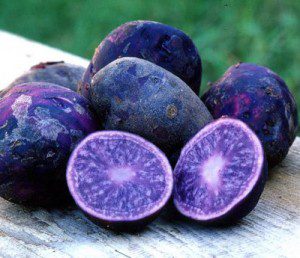By Emily Main – organicgardening.com
Ward off bad moods with a mood-boosting backyard garden.
Just being outside, whether you’re gardening, exercising, or simply taking a stroll, is a great mood booster. But getting your hands dirty in a garden is so effective at combating depression that it’s often used in “horticultural therapy” at psychiatric hospitals. If you feel like your energy levels are dropping or you’re just too stressed out at work, plant yourself a good-mood garden, and get the benefits not just of a little garden therapy but of all the healthy foods linked to lower rates of depression. Certain vegetables and herbs are rich in antidepressant compounds and minerals that can do everything from taking the edge off a bad day to curing full-blown depression.
Here’s a guide to get you started—10 of the most potent antidepressant foods and herbs and how to grow them anywhere.
1. Swiss Chard
Eat it: All types of chard are packed with magnesium, a nutrient essential for the biochemical reactions in the brain that boost your energy levels. In fact, magnesium deficiency is a common condition among people diagnosed with clinical depression.
Grow it: Chard is a hardy crop that, if planted even as late as summer, will produce until early winter. Pick a spot that gets a fair amount of sunlight; it can tolerate shade but produces best with lots of sun. Or choose a container that’s about 12 inches wide and 12 inches deep and fill it with a good all-purpose potting soil. Sow between 2 and 3 seeds per pot. You can start harvesting leaves as soon as they appear, but harvest from the outside so as not to kill the entire plant.
2. Blue Potatoes
Eat it: The anthocyanin antioxidants in rare—but tasty!—blue potatoes reduce inflammation that can lead to bad moods. Their skin is also packed with iodine, which helps stabilize thyroid hormone levels, thus warding off mood swings.
Grow it: Potatoes are about the easiest crops to grow. You can even grow them in a bag of potting soil, without really dirtying your hands. To do that, cut a few drainage holes at the bottom of a bag of potting soil, then stand the bag someplace sunny. Bury two “seed potatoes” about 4 inches deep, and wait about 3 months for them to grow. When flowers start to appear, tip the bag over and dig out the potatoes. To keep the harvest going long into the fall, plant a new set of seed potatoes every few weeks.
Read More: 7 Ways to Plant Potatoes
3. Cherry Tomatoes
Eat it: Tomato skin is rich in lycopene, a phytonutrient that actually stops the buildup of pro-inflammatory compounds linked to depression. Because lycopene lives in tomato skins, the best way to get it is through cherry tomatoes, whose smaller surface area means you’ll eat more skin than if you eat a full-size tomato.
Grow it: Cherry tomatoes are good choices for containers, and they’ll produce more fruit than larger varieties. The pots should be large—one that holds 4 to 6 gallons of potting soil will do—and placed in a sunny spot. In June, find some organic cherry-tomato seedlings at a local nursery or farmers’ market (big-box-store tomato plants can be very disease-prone), and plant them so that the first row of leaves is covered by dirt. Depending on the variety you grow, cherry tomatoes can take about 2 to 3 months to start bearing fruit.
Learn More: How to Grow Tomatoes
4. Black-Eyed Peas
Eat it: Black-eyed peas have some of the highest levels of folate of any vegetable. It’s thought that folate plays a role in creating dopamine, serotonin, and norepinephrine, three brain chemicals that, when absent, can make you forgetful, irritable, and unable to sleep.
Grow it: Black-eyed peas need long summers with temperatures averaging between 60 ° and 70 °F, which is why they’re so commonly grown down South. They need warm days and warm nights, with lots of sun and water. After you plant them, they’ll be ready to harvest in a little over three months. You can eat them fresh off the vine, or leave them on the vine until they dry (you’ll hear seeds rattling around in the pods) and save them to eat all winter.
5. Oregano
Eat it: Oregano is rich in caffeic acid, quercitin, and rosmarinic acid, all components that combat depression, fatigue, and anxiety.
Grow it: Oregano, like most herbs, is easy to grow. Look for a seedling at a local nursery, pot it, and just water as needed, leaving the soil on the dry side. It thrives better in containers, but make sure your pot is fairly large—at least 12 inches across—as this plant can grow pretty quickly.
Learn More: 10 Best Herbs for Growing Indoors
6. Sunflower
Eat it: Sunflower seeds are a great source for the antidepressant phenylalanine, an amino acid the body turns into norepinephrine.
Grow it: Sunflowers like sun, obviously, but be sure to plant them in a sunny spot on the north edge of your yard or garden so they don’t cast too much shade on other sun-loving plants. Plant your seeds after the last frost. Towards the end of summer, the flowers start to wilt and the seed heads ripen and droop. When the seeds in the seed heads start to turn brown, cut them along with 2 feet of stem and hang upside down in a dry, well-ventilated place, such as a garage or attic, until fully dry; store in plastic bags for birds and animal food. To eat, soak overnight in water (or strong salt water, if a salty flavor is desired), drain, spread on a shallow baking sheet, and roast for 3 hours at 200 °F or until crisp.
Read More: A Sunflower Revolution
7. Chamomile
Drink it: There’s a reason a cup of chamomile tea just before bed helps you sleep. Just like oregano, it’s rich in stress-reducing caffeic acid and quercitin, but it tastes much better in the form of tea, which you can make from your garden herbs by steeping chamomile flowers in boiling water for about 10 minutes.
Grow it: German chamomile is best for teas, as opposed to other varieties that can taste bitter. Since it can grow wild and take over your garden, it’s best suited for containers. A small container about 6 inches wide by 6 inches deep will suffice, but a bigger pot will yield a bigger harvest. It prefers full sun and should be planted in late spring, when there’s no risk for frost.
Learn more: Herbal Teas under the Microscope
8. Evening Primrose
Eat it: Evening primrose is technically a wildflower. Its seeds have the highest levels of tryptophan (which your body uses to make mood-boosting serotonin) of any plant. In the fall, when the flowers mature, the flowers’ seed pods begin to fill up. Harvest a few and grind them as you would flaxseed into your favorite dishes.
Grow it: Evening primrose is drought-tolerant and easy to grow either in containers or in the ground. You can find varieties with flowers ranging from deep reds to light yellows. Sow the seeds in groups of four. They’ll start to appear in 14 to 28 days.
Read More: Organic Guide to Edible Flower
9. Lavender
Smell it: Gardens don’t have to be all about edibles (even though you can eat lavender). According to the University of Maryland Medical Center, aromatherapy treatments involving lavender and a few other herbs are often used to supplement depression treatments, because the scent is so relaxing.
Grow it: Plant a lavender seedling in a container made from a material that breathes, such as terra-cotta, and choose a pot about 12 inches wide by 12 inches deep. Place your pot in an area that gets lots of sunlight; lavender loves dry, sunny areas. English lavender is both fragrant and edible, if you feel like adding some lavender flowers to your cooking.
More: Top 10 Flowering Herbs
10. St. John’s Wort
Drink it: The most famous herbal antidepressant, St. John’s wort contains compounds similar to those found in Prozac. The flowers and leaves are the most valuable part of the plant and can be brewed into a tea that will calm you down and boost your mood. Just note that St. John’s wort has many adverse drug interactions, so check with a pharmacist if you’re on any medications.
Grow it: Another herb that’s often viewed as a weed, St. John’s wort should be grown in containers to keep it from spreading where you don’t want it. It’s pretty easy to grow. Just find a seedling or some seeds and plant them in a small container placed in a partially sunny/partially shady area. Plant the herb in spring, and by July you’ll start to see leaves. But flowers won’t show up until the second year (St. John’s wort is a perennial, so you can leave it in its pot all winter and it’ll grow back on its own).
Source – organicgardening.com

If you've ever found value in our articles, we'd greatly appreciate your support by purchasing Mindful Meditation Techniques for Kids - A Practical Guide for Adults to Empower Kids with the Gift of Inner Peace and Resilience for Life.
In the spirit of mindfulness, we encourage you to choose the paperback version. Delve into its pages away from screen glare and notifications, allowing yourself to fully immerse in the transformative practices within. The physical book enriches the learning process and serves as a tangible commitment to mindfulness, easily shared among family and friends.
Over the past few years, Wake Up World has faced significant online censorship, impacting our financial ability to stay online. Instead of soliciting donations, we're exploring win-win solutions with our readers to remain financially viable. Moving into book publishing, we hope to secure ongoing funds to continue our mission. With over 8,500 articles published in the past 13 years, we are committed to keeping our content free and accessible to everyone, without resorting to a paywall.







